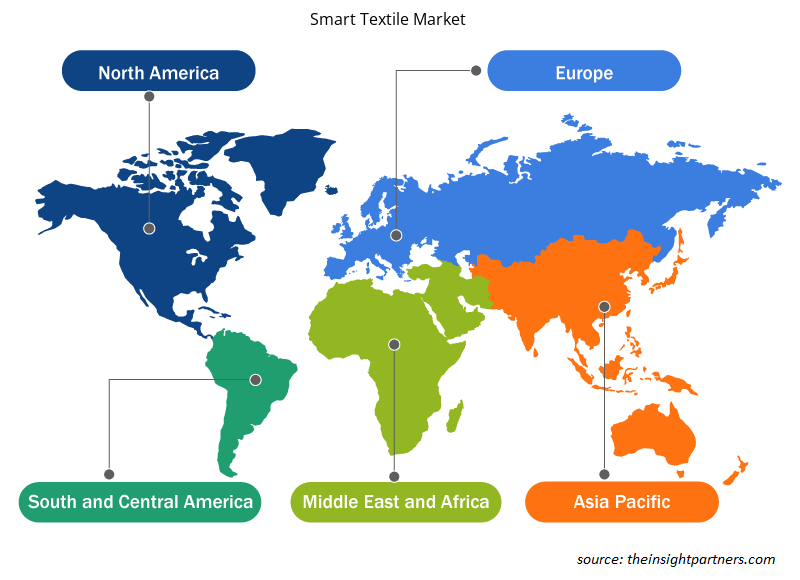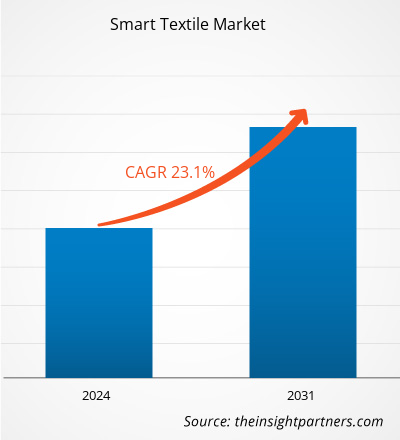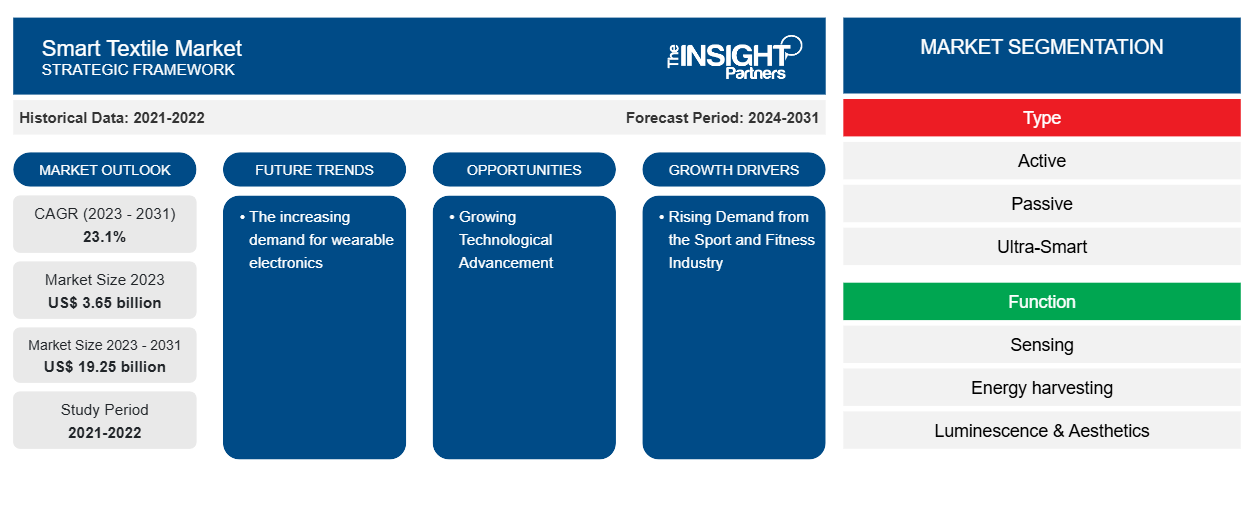Der Markt für intelligente Textilien soll von 3,65 Milliarden US-Dollar im Jahr 2023 auf 19,25 Milliarden US-Dollar im Jahr 2031 anwachsen. Der Markt wird voraussichtlich zwischen 2023 und 2031 eine durchschnittliche jährliche Wachstumsrate (CAGR) von 23,1 % verzeichnen. Die steigende Nachfrage nach tragbarer Elektronik dürfte ein wichtiger Trend auf dem Markt für intelligente Textilien bleiben.
Marktanalyse für intelligente Textilien
Dank der Fortschritte bei intelligenten Textilmaterialien hat die Textilbranche einen enormen Wandel erlebt. Unternehmen konnten dadurch ihre Reichweite auf Hightech-Anwendungen und Bereiche außerhalb ihres herkömmlichen Marktes ausdehnen. Intelligente Textilien sind Materialien, in die Rechenleistung eingebettet wurde, um zusätzliche Funktionen wie Stimulation, Kommunikation und Überwachung zu bieten. Die Branche für tragbare Elektronik wächst aufgrund abnehmender Downsizing-Trends in der modernen Elektronik und der steigenden Nachfrage nach intelligenten Geräten. Die Entwicklung von RFID , Sensortechnologien und Nanotechnologie in Textilien hat die Marktexpansion ebenfalls vorangetrieben.
Marktübersicht für intelligente Textilien
Intelligente Textilien sind Textilien, die mit digitalen Elementen wie leitfähigen Fasern, Mikrocontrollern und Sensoren kombiniert wurden. Diese Textilien besitzen die Fähigkeit, Veränderungen in ihrer Umgebung oder Reize chemischer, mechanischer oder thermischer Art wahrzunehmen, darauf zu reagieren und sich darauf einzustellen. Im Gegensatz zu herkömmlichen Materialien verfügen intelligente Textilien über interaktive Funktionen, die Daten übertragen können. Sie werden immer häufiger im Gesundheitswesen, im Sport, in der Modebranche und im Militär eingesetzt. Im Gesundheitswesen können sie Vitalfunktionen überwachen und medizinisches Personal benachrichtigen. Sie sind in der Lage, Leistungsparameter im Sport zu verfolgen. Zu den militärischen Einsatzmöglichkeiten gehören verbesserte Tarnung und Körperschutz mit integrierten Kommunikationsgeräten.
Passen Sie diesen Bericht Ihren Anforderungen an
Sie erhalten kostenlos individuelle Anpassungen an jedem Bericht, einschließlich Teilen dieses Berichts oder einer Analyse auf Länderebene, eines Excel-Datenpakets sowie tolle Angebote und Rabatte für Start-ups und Universitäten.
-
Holen Sie sich die wichtigsten Markttrends aus diesem Bericht.Dieses KOSTENLOSE Beispiel umfasst eine Datenanalyse von Markttrends bis hin zu Schätzungen und Prognosen.
Treiber und Chancen auf dem Smart Textile-Markt
Steigende Nachfrage aus der Sport- und Fitnessbranche
Fitnessbegeisterte und Sportler sind ständig auf der Suche nach Methoden, um Trainingsergebnisse und Leistung zu verbessern. Intelligente Textilien eignen sich perfekt für diesen Optimierungsprozess. Diese Textilien, die von Socken zur Ganganalyse bis hin zu Shirts zur Aufzeichnung der Muskelaktivität reichen, liefern eine Vielzahl von Daten, die zur Anpassung von Trainingsplänen und zur Vermeidung von Unfällen genutzt werden können. Darüber hinaus können die erfassten Daten mit Smartphones oder anderen Geräten synchronisiert werden, sodass sofortige Maßnahmen als Reaktion auf Echtzeit-Feedback möglich sind. Sportler und Freizeitläufer können nun gleichermaßen auf diesen Grad an feinkörniger Datenerfassung zugreifen, der bisher spezialisierten Sportlabors vorbehalten war. Darüber hinaus treibt der zunehmende globale Fokus auf Gesundheits- und Wellnesstrends die Nachfrage nach intelligenten Textilien im Sport- und Fitnessbereich an, da sie eine einfache Möglichkeit bieten, zahlreiche Daten zu überwachen, die zu einem besseren und aktiveren Lebensstil beitragen können.
Wachsender technologischer Fortschritt
Das Textilgeschäft hat sich durch die Einführung neuer Technologien wie künstliche Intelligenz (KI) und das Internet der Dinge (IoT) verändert. KI, Bluetooth Low Energy (BLE), Edge Computing und Cloud-Daten werden alle in der Produktion neuer intelligenter Kleidung kombiniert. Diese Kleidung kann die Daten des Trägers überwachen und übertragen, wie etwa Temperatur, Herzfrequenz, Blutdruck und Schweiß. KI ist in der Lage, Betriebsdaten sowohl aus der Vergangenheit als auch aus der Gegenwart abzurufen und zu sammeln sowie Erkenntnisse zu liefern, die die Produktivität des Trägers verbessern können. KI wird in der Textilherstellung häufig für eine Vielzahl von Zwecken verwendet, darunter Farbabstimmung, Musterprüfung und Fehlererkennung. Darüber hinaus hat die Integration von KI die Herstellung intelligenter Kleidung ermöglicht, die elektrische und IoT-Sensoren verwendet, um ein großartiges Benutzererlebnis zu bieten. Somit kann die Einbindung von Technologien in Textilien ein komfortableres und gesundheitsorientierteres Erlebnis schaffen, was im Prognosezeitraum voraussichtlich eine Chance für das Wachstum des Marktes für intelligente Textilien schaffen wird.
Segmentierungsanalyse des Marktberichts für intelligente Textilien
Wichtige Segmente, die zur Ableitung der Smart Textile-Marktanalyse beigetragen haben, sind Typ, Funktion und Branche.
- Basierend auf dem Typ ist der Markt für intelligente Textilien in aktive, passive und ultraintelligente Textilien unterteilt. Das aktive Segment dürfte im Prognosezeitraum wachsen.
- Nach Funktion ist der Markt in Sensorik, Energiegewinnung, Lumineszenz & Ästhetik sowie Thermoelektrizität unterteilt. Das Sensoriksegment dürfte im Prognosezeitraum wachsen.
- Nach Branchen ist der Markt in Gesundheitswesen, Sport & Fitness, Mode, Militär und Automobil unterteilt. Das Segment Sport & Fitness dürfte im Prognosezeitraum wachsen.
Smart Textile Marktanteilsanalyse nach Geografie
Der geografische Umfang des Smart Textile-Marktberichts ist hauptsächlich in fünf Regionen unterteilt: Nordamerika, Asien-Pazifik, Europa, Naher Osten und Afrika sowie Südamerika/Süd- und Mittelamerika.
In Bezug auf den Umsatz hatte Nordamerika den größten Marktanteil im Bereich Smart Textiles. Der Markt in dieser Region ist in die USA, Kanada und Mexiko unterteilt. Die Expansion des regionalen Marktes wird durch steigende staatliche Investitionen in die Verteidigungs- und Militärindustrie sowie eine starke Kaufkraft vorangetrieben. Darüber hinaus leidet ein großer Teil der Bevölkerung in der Region an Fettleibigkeit, was sie zu einer der größten gesundheitlichen Herausforderungen macht. Infolgedessen tendieren die Verbraucher zu einem gesunden Lebensstil und kaufen Waren, die ihre fortgesetzte körperliche Aktivität unterstützen. Um wettbewerbsfähig zu bleiben, konzentrieren die Marktteilnehmer ihre Bemühungen daher darauf, hochmoderne Artikel zu erschwinglichen Preisen anzubieten. Darüber hinaus treiben die steigenden staatlichen Ausgaben für F&E-Initiativen, insbesondere im Gesundheitssektor, das Wachstum des Marktes für Smart Textiles weiter voran.
Regionale Einblicke in den Smart Textile-Markt
Die regionalen Trends und Faktoren, die den Smart Textile-Markt im Prognosezeitraum beeinflussen, wurden von den Analysten von Insight Partners ausführlich erläutert. In diesem Abschnitt werden auch die Marktsegmente und die Geografie des Smart Textile-Marktes in Nordamerika, Europa, im asiatisch-pazifischen Raum, im Nahen Osten und Afrika sowie in Süd- und Mittelamerika erörtert.

- Holen Sie sich die regionalspezifischen Daten für den Smart Textile-Markt
Umfang des Marktberichts für intelligente Textilien
| Berichtsattribut | Details |
|---|---|
| Marktgröße im Jahr 2023 | 3,65 Milliarden US-Dollar |
| Marktgröße bis 2031 | 19,25 Milliarden US-Dollar |
| Globale CAGR (2023 - 2031) | 23,1 % |
| Historische Daten | 2021-2022 |
| Prognosezeitraum | 2024–2031 |
| Abgedeckte Segmente |
Nach Typ
|
| Abgedeckte Regionen und Länder |
Nordamerika
|
| Marktführer und wichtige Unternehmensprofile |
|
Marktteilnehmerdichte: Der Einfluss auf die Geschäftsdynamik
Der Markt für intelligente Textilien wächst rasant. Die Nachfrage der Endverbraucher steigt aufgrund von Faktoren wie sich entwickelnden Verbraucherpräferenzen, technologischen Fortschritten und einem größeren Bewusstsein für die Vorteile des Produkts. Mit der steigenden Nachfrage erweitern Unternehmen ihr Angebot, entwickeln Innovationen, um die Bedürfnisse der Verbraucher zu erfüllen, und nutzen neue Trends, was das Marktwachstum weiter ankurbelt.
Die Marktteilnehmerdichte bezieht sich auf die Verteilung der Firmen oder Unternehmen, die in einem bestimmten Markt oder einer bestimmten Branche tätig sind. Sie gibt an, wie viele Wettbewerber (Marktteilnehmer) in einem bestimmten Marktraum im Verhältnis zu seiner Größe oder seinem gesamten Marktwert präsent sind.
Die wichtigsten auf dem Smart Textile-Markt tätigen Unternehmen sind:
- Dupont
- Jabil
- Sensorik
- Interaktive Kleidung AG
- Adidas
- Hexoskin
Haftungsausschluss : Die oben aufgeführten Unternehmen sind nicht in einer bestimmten Reihenfolge aufgeführt.

- Überblick über die wichtigsten Akteure auf dem Smart Textile-Markt
Neuigkeiten und aktuelle Entwicklungen zum Smart Textile-Markt
Der Markt für intelligente Textilien wird durch die Erhebung qualitativer und quantitativer Daten nach Primär- und Sekundärforschung bewertet, die wichtige Unternehmensveröffentlichungen, Verbandsdaten und Datenbanken umfasst. Im Folgenden finden Sie eine Liste der Entwicklungen auf dem Markt:
- Loomia Technologies hat sich mit Advanced Functional Fabrics of America (AFFOA) zusammengetan, um hochtaktile, beheizte Handbekleidung zu entwickeln, die sowohl für gewerbliche/Freizeit- als auch für militärische Kunden geeignet sein könnte. Für dieses Gemeinschaftsprojekt wird Loomia Technologie für den Einsatz in einem beheizten Handschuheinsatz bereitstellen, während AFFOA die Kundensuche leitet, Systemarchitekturentwürfe liefert und eine Schnittstellensteuereinheit produziert. Neben dem beheizten Handschuheinsatz wird Loomia auch einen beheizten Ärmel entwickeln. Beide Artikel bieten Benutzern in rauen Klimazonen oder anderen Gebieten, in denen dieser Schutz als notwendig erachtet wird, thermischen Komfort. (Quelle: Loomia Technologies, Pressemitteilung, 2022)
- Die UK Fashion and Textile Association (UKFT) hat eine Partnerschaft mit der Smart Textile Alliance bekannt gegeben. Die Partnerschaft zwischen STA und UKFT wird für beide Seiten von Vorteil sein und das Potenzial für neue Wege der Innovation in Technologie und Mode eröffnen. (Quelle: UKFT, Pressemitteilung, 2021)
Marktbericht zu intelligenten Textilien – Umfang und Ergebnisse
Der Bericht „Marktgröße und Prognose für Smart Textiles (2021–2031)“ bietet eine detaillierte Analyse des Marktes, die die folgenden Bereiche abdeckt:
- Marktgröße und Prognose auf globaler, regionaler und Länderebene für alle wichtigen Marktsegmente, die im Rahmen des Projekts abgedeckt sind
- Marktdynamik wie Treiber, Beschränkungen und wichtige Chancen
- Wichtige Zukunftstrends
- Detaillierte PEST/Porters Five Forces- und SWOT-Analyse
- Globale und regionale Marktanalyse mit wichtigen Markttrends, wichtigen Akteuren, Vorschriften und aktuellen Marktentwicklungen
- Branchenlandschaft und Wettbewerbsanalyse, einschließlich Marktkonzentration, Heatmap-Analyse, prominenten Akteuren und aktuellen Entwicklungen
- Detaillierte Firmenprofile
- Historische Analyse (2 Jahre), Basisjahr, Prognose (7 Jahre) mit CAGR
- PEST- und SWOT-Analyse
- Marktgröße Wert/Volumen – Global, Regional, Land
- Branchen- und Wettbewerbslandschaft
- Excel-Datensatz
Aktuelle Berichte
Erfahrungsberichte
Grund zum Kauf
- Fundierte Entscheidungsfindung
- Marktdynamik verstehen
- Wettbewerbsanalyse
- Kundeneinblicke
- Marktprognosen
- Risikominimierung
- Strategische Planung
- Investitionsbegründung
- Identifizierung neuer Märkte
- Verbesserung von Marketingstrategien
- Steigerung der Betriebseffizienz
- Anpassung an regulatorische Trends























 Kostenlose Probe anfordern für - Markt für intelligente Textilien
Kostenlose Probe anfordern für - Markt für intelligente Textilien